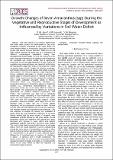| dc.description.abstract | Soil water deficit is a principal a biotic factor that limits plant growth and development in dry areas. Insufficient moisture contributes to soil water deficit and some negative effects on Amaranthus (spp) such as reduced growth and altered biomass allocation. Differences in soil water deficit responses of plants may be a consequence of different morphological adaptations during their developmental growth stages. In arid and semi-arid areas, water shortage is becoming an increasing problem because of the unreliable and limited rainfall and it significantly contributes to food shortage especially in Kenya. During the vegetative stage amaranth leaves are harvested while during the reproductive stage their seeds are harvested this makes its growth stages critical. Despite this obvious advantages, and besides it being the most popular and widely consumed micronutrient rich African indigenous Leafy Vegetables in Kenya, published information is limited concerning the growth stages of amaranth species in response to soil water deficit. These research was therefore designed to evaluate the seven widely cultivated amaranth species in Kenya:- Amaranthus blitum (L), Amaranthus retroflexus (L), Amaranthus Spinosus (L), Amaranthus albus (L), Amaranthus cruentus (L), Amaranthus hypochondriacus (L) and Amaranthus tricolor (L). to soil water deficit in relation to their growth. The experiment was carried out at Kenya Agricultural and Livestock Research Organisation, Kisii Centre. The experiment was laid out as completely randomized design, consisting of four treatments, seven species and three replications. The treatments were: 100%, 75%, 50% and 25% available water capacity. Growth parameters measured included; plant height and the stem diameter using a meter rule and a veneer calliper respectively, and by counting the number of leaves. The root to shoot ratio was determined at the end of the experiment. Soil moisture content was determined gravimetrically. Data was subjected to analysis of variance and separation of means using the Least Significant Difference at 5% level. Results showed that the seven species of amaranth were significantly (p≤0.05) affected by soil water deficit. Growth parameters during the vegetative and reproductive stages decreased with increase in water deficit and reduced significantly (p≤0.05) with further increase in water deficit. The root to shoot ratio increased with increase in soil water deficit. From the results obtained, it can be concluded that among the seven species of amaranthus evaluated, A albus, had the highest growth to soil water deficit and therefore can be recommended to be grown in water deficient regions followed by A. hypochondriacus, A. cruentus, A. retroflexus, A. blitum, A. Spinosus, and A. tricolor respectively. The results of this study can also be used to recommend better management plant strategies to drought, as it considered the effects of soil water deficit on both the vegetative and reproductive stages of growth. | en_US |

